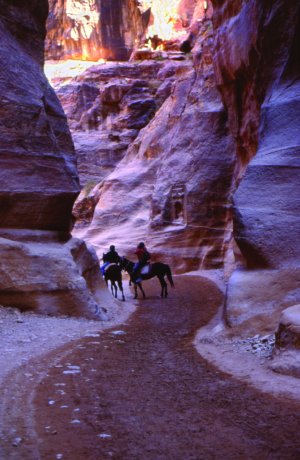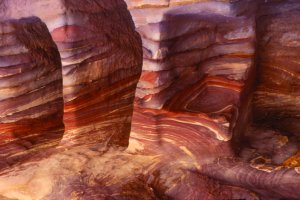articles/Travel/petra-page2
Petra - part 2 of 1 2 3
Published 01/10/2001

It is thought that the site of Petra was first used by the Edomites in about l000 BC. They are said to be descendants of Esau and occupied the area for about 700 years. In approximately 300 BC the Nabataeans drove them out and made Petra their capital. Although to begin with their dwellings were no more than rock overhangs or shallow caves.
By now we were in shadow. The walls of the Siq had increased to about 100 metres in height and in places the track narrowed to 2 to 3 metres. Occasional shafts of sunlight lit portions of the surrounding rock, picking out eroded carvings or the water channel -- formed high on one wall --which had carried life into the city from the Nabataean reservoir built in front of the entrance to the Siq.
With the serpentine track continuing to narrow, our forward view became restricted to a maximum of 20 to 30 metres until, suddenly, we turned a corner and there before us were the sunlit columns of el-Khazneh ("the Treasury").
Like so many others, I had seen the famous pictures but nothing had prepared me for this first view. I knew, already, that Petra would not disappoint me.

El-Khazneh is, in reality, a tomb and apparently got its name as "the Treasury" from the fact that, last century, the Bedou inhabitants thought that the urn, surmounting the carved front of the tomb, contained great treasure. Unfortunately, it did not!
At this point it is worth mentioning an experience recounted by our leader. On a previous trip he met an English couple returning through the Siq. On being asked what they thought of Petra, they replied that "it was all right" but as they had already seen a photograph of it, it had hardly been worth the visit! Apparently, they had not realised that there is far more to Petra than merely "the Treasury" and had turned back once they had seen that tomb.
And far more there certainly is! The site of excavated Petra covers an area of some 5 to 6 square miles and it seems that wherever one looks there are ancient ruins: the 7000 seat theatre built by the Nabataeans about the time of Christ and refurbished by the Romans in about 106 AD; the colonnaded street, again, built by the Romans of the same period; The High Place Of Sacrifice with its Nabataean alter and its panoramic views over the ancient city; or, ed-Deir ( "the monastery" ) where those with a head for heights could scramble up the rocks to one side and stand on its very roof; so high that the people below really did look ant sized.
I cannot properly express the awe and wonderment I experienced as I gazed at the examples of man's stupendous work, both built into and carved out of the living rock: the shear effort required to excavate and carve the sandstone into columns and plinths and urns.
Please Note:
There is more than one page for this Article.
You are currently on page 2
1st Published 01/10/2001
last update 21/07/2022 08:49:44
More Travel Articles
The Society of Photographers Convention and Trade Show at The Novotel London West, Hammersmith ...
You have 37 days until The Society of Photographers Convention Wednesday 14th January 2026




